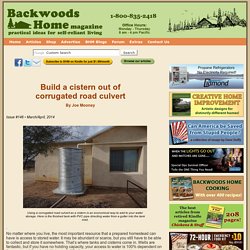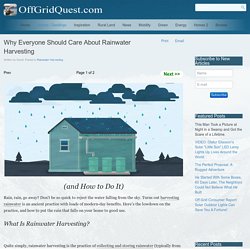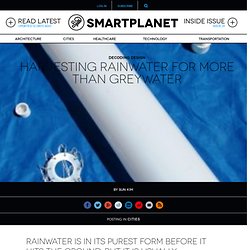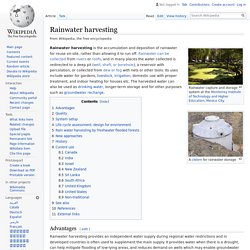

Modern home in Mexican plateau revives ancient water harvest. Watercone: Air Water Distiller and Harvester. Posted Categories: Rainwater Harvesting What is a Watercone?

A Product that enables anyone, in a most simple fashion, an independent, cheap and mobile solar Potable Water generation from sea water or brackish water on the base of condensation by solar still. This Invention represents a conical, self-supporting and stackable Unit made from transparent, thermo-formable polycarbonate (same as water dispensers) outfitted with a screw cap spout at the tip and an inward circular collecting trough at the base.
Technically speaking it is a solar still. Pour salty / brackish Water into pan. The evaporated Water condensates in the form of droplets on the inner wall of the cone. Drinking Rainwater. NEW!

Stencils for Tiny House Design Search Also see… Comments Policy. 100-Year-Old Way to Filter Rainwater in a Barrel. During our boiling, broiling, blistering summer of 2012 here in the Missouri Ozarks, water was a topic of conversation wherever we went.

Creeks and ponds dried up (some never recovered) and the water table dropped, forcing a few neighbors to have their well pumps lowered or to even have deeper wells drilled. Many folks shared memories of rain barrels, cisterns, hand pumps and drawing water with a well bucket as a child, usually on grandpa and grandma’s farm. Some said they’d never want to rely again on those old-time methods of getting water. But, at least they knew how it was done. It seems we have lost much practical knowledge in the last 50 or so years because we thought we’d never need it again. Build a cistern out of corrugated road culvert. Using a corrugated road culvert as a cistern is an economical way to add to your water storage.

Here is the finished tank with PVC pipe directing water from a gutter into the tank inlet. No matter where you live, the most important resource that a prepared homestead can have is access to stored water. A New Place to Store Rainwater: The Fence. Facebook. Why Everyone Should Care About Rainwater Harvesting. (and How to Do It) Rain, rain, go away?

Don’t be so quick to reject the water falling from the sky. Turns out harvesting rainwater is an ancient practice with loads of modern-day benefits. Here’s the lowdown on the practice, and how to put the rain that falls on your home to good use. Simple Rain Barrel System Collects 825 Gallons of Water. This simple rain barrel configuration collects over 825 gallons of water from the rain gutter on one house.

Using PVC pipes, these inexpensive 55-gallon plastic barrels are connected together in an overflow system, enabling the property owner to collect large amounts of water for the gardens and trees on his property. By collecting and storing water during rainfalls, he never has to use city water for his plants during dry periods.
To support the weight of the full barrels, they are arranged on a frame constructed of wood atop steel fence posts anchored in concrete. A shut off valve was placed at the end of the pipe system. A valve like this prevents drips, as discovered through trial and error. This 15 barrel configuration is actually acting as the overflow to a smaller group of barrels that sit next to the house. See more about this configuration in this video: Off Grid Rainwater System Collects, Stores, and Purifies Water. This rainwater collection system in the Canadian wilderness has provided a source of clean, potable water for this family of four’s off grid cabin for almost 20 years.

The system is relatively simple and very low maintenance. Water is collected using a three hundred square foot piece of metal roofing, where it flows downhill into a gutter. It is passed through a layer of plastic mesh as it runs into the gutter to filter out any large debris, including the needles that drop onto the roof from surrounding trees. The water is then passed through a course filter as it leaves the gutter, filtering out even more of the larger debris. After leaving the course filter, the water is run down a pipe and through a fine filter where it is further cleansed before it enters the 2000-gallon storage tank. Filtering and chlorinating the water before it reaches the tank has significantly lowered the amount of maintenance required to keep the tank clean in its 20 years of use.
Vattensamlare - Watersystem. Rainus - Watersystem. Trädgård - Watersystem. Återvinning - Watersystem. Www.plastinject.se/media/4083/RW-Katalog-2010.pdf. Återvinning - Watersystem. 26851601.jpg (1061×892) Gallery: Best Water Filter in the World – Available to your NGO! Water Storage: Tanks, Cisterns, Aquifers, and Ponds for Domestic Supply, Fire and Emergency Use. Rain Water Harvesting by Freshwater Flooded Forests. Harvesting rainwater for more than greywater. Rainwater is in its purest form before it hits the ground, but it is usually collected for non potable uses only.

What if that huge, free source of naturally distilled water could be used for drinking and cooking? A simple rain collection module named RainSaucers makes potable rainwater possible. The RainSaucer, developed by Tom Spargo, decreases the chances of rainwater contamination by decreasing the instances of contact with building surfaces (roof, gutters, downspouts.)
Resembling an upside down umbrella, the RainSaucer is made of five components: a food grade polypropylene 'saucer', pipe fitting, mesh filter, fasteners, and a retention ring for wind resistance. The surface of the Saucer harvests 6.75 gallons per inch of rain and can work with any container. Rainwater harvesting. Rainwater harvesting is the accumulation and deposition of rainwater for reuse on-site, rather than allowing it to run off.

Rainwater can be collected from rivers or roofs, and in many places the water collected is redirected to a deep pit (well, shaft, or borehole), a reservoir with percolation, or collected from dew or fog with nets or other tools. Its uses include water for gardens, livestock, irrigation, domestic use with proper treatment, and indoor heating for houses etc. The harvested water can also be used as drinking water, longer-term storage and for other purposes such as groundwater recharge. Advantages[edit] Rainwater harvesting provides an independent water supply during regional water restrictions and in developed countries is often used to supplement the main supply.
More development and knowledge is required to understand the benefits rainwater harvesting can provide to agriculture. Quality[edit] System setup[edit] Life cycle assessment: design for environment[edit] Rainwater Harvesting for Drylands (Vol. 1): Guiding Principles to Welcome Rain into Your Life And Landscape: Brad Lancaster: 9780977246403: Amazon.com: Books. Rainwater Harvesting. Water is essential to life, for we cannot exist without it.

We are running short of fresh, clean water in many parts of the USA. That is also the case in many other countries. Those who live in the northeastern quadrant of the lower 48 states are generally in good shape for now, water-wise, though there may be local issues with clean water in places.